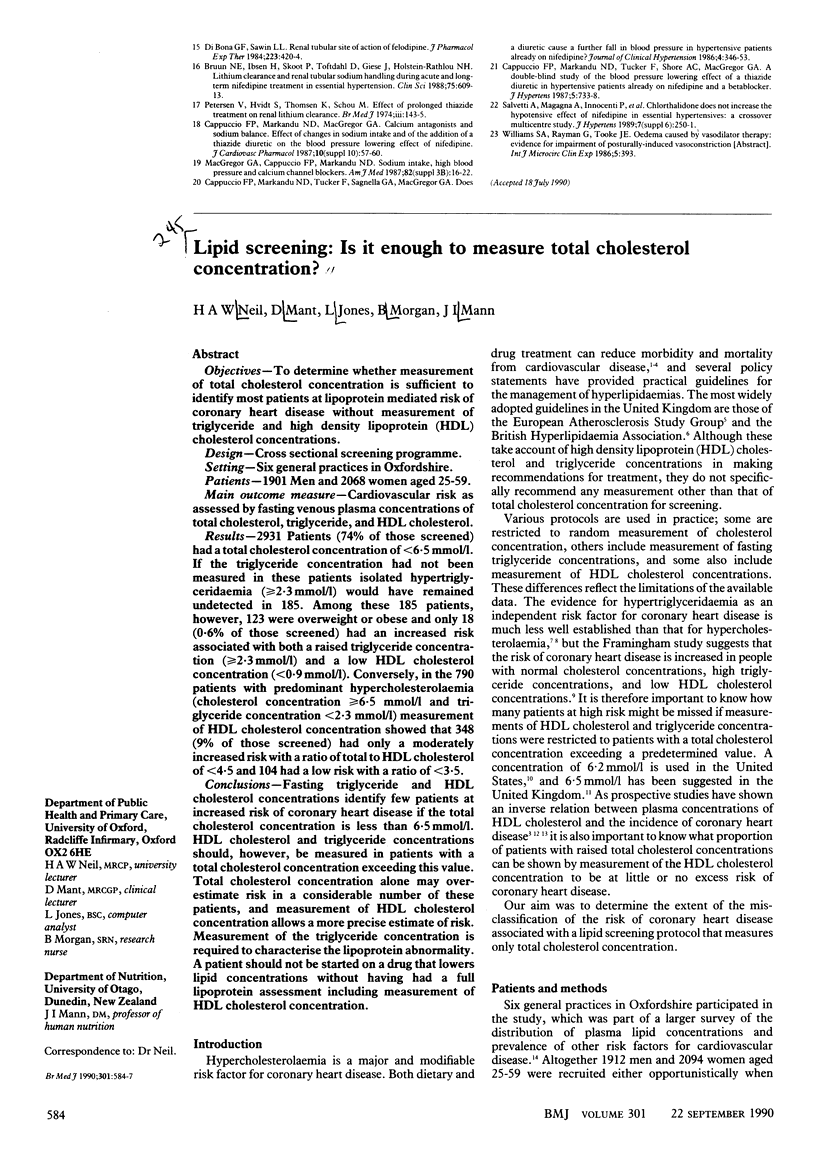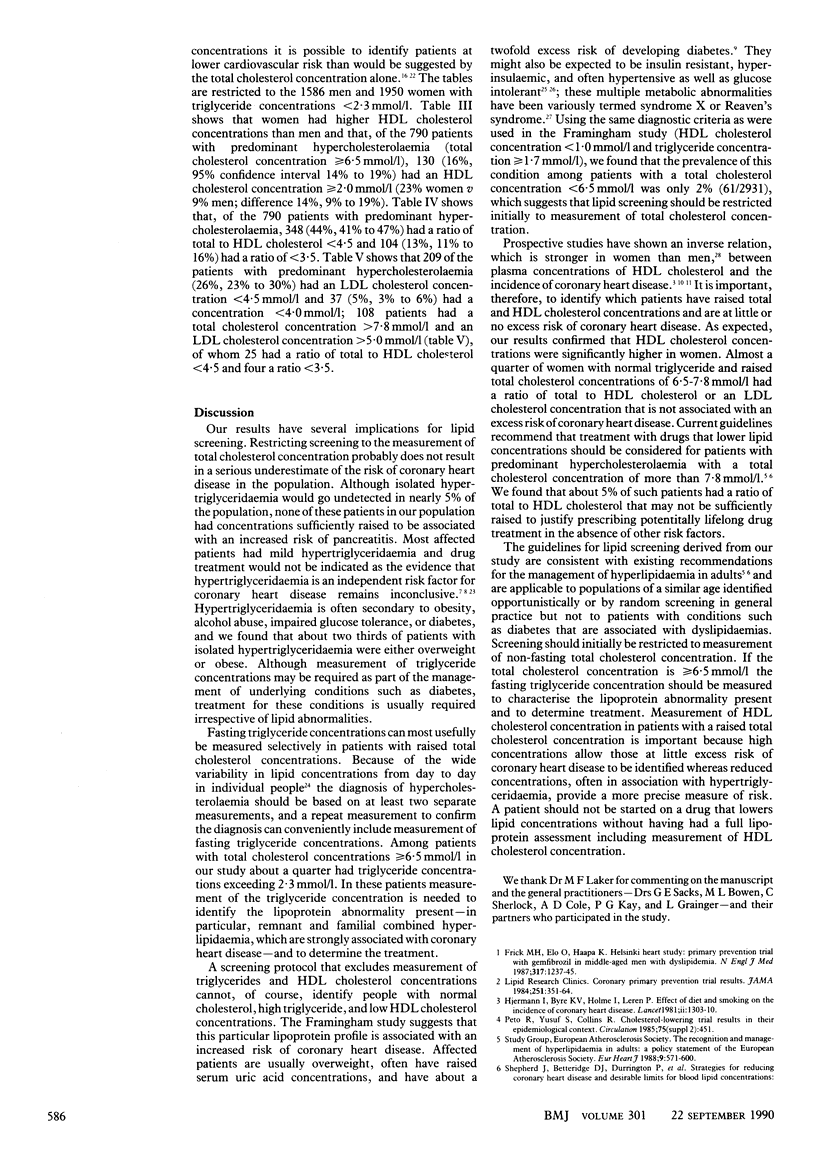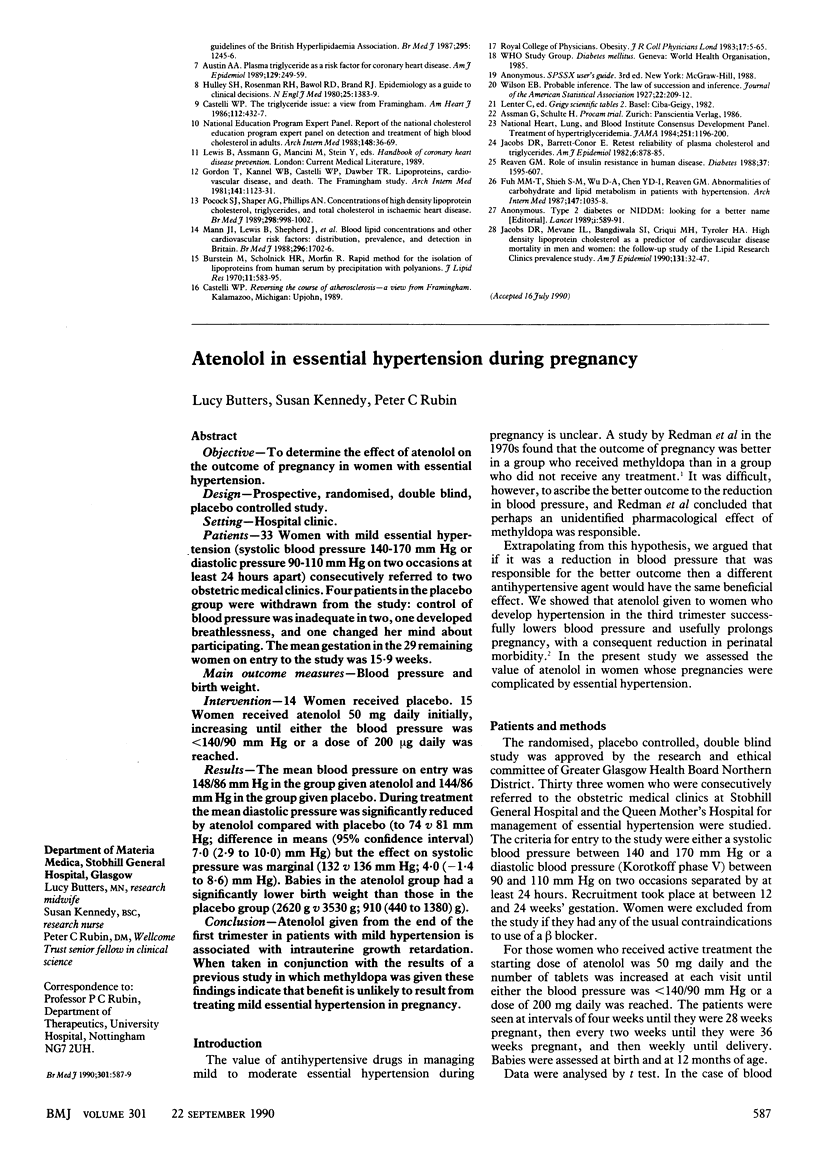Abstract
OBJECTIVES--To determine whether measurement of total cholesterol concentration is sufficient to identify most patients at lipoprotein mediated risk of coronary heart disease without measurement of triglyceride and high density lipoprotein (HDL) cholesterol concentrations. DESIGN--Cross sectional screening programme. SETTING--Six general practices in Oxfordshire. PATIENTS--1901 Men and 2068 women aged 25-59. MAIN OUTCOME MEASURE--Cardiovascular risk as assessed by fasting venous plasma concentrations of total cholesterol, triglyceride, and HDL cholesterol. RESULTS--2931 Patients (74% of those screened) had a total cholesterol concentration of less than 6.5 mmol/l. If the triglyceride concentration had not been measured in these patients isolated hypertriglyceridaemia (greater than or equal to 2.3 mmol/l) would have remained undetected in 185. Among these 185 patients, however, 123 were overweight or obese and only 18 (0.6% of those screened) had an increased risk associated with both a raised triglyceride concentration (greater than or equal to 2.3 mmol/l) and a low HDL cholesterol concentration (less than 0.9 mmol/l). Conversely, in the 790 patients with predominant hypercholesterolaemia (cholesterol concentration greater than or equal to 6.5 mmol/l and triglyceride concentration less than 2.3 mmol/l) measurement of HDL cholesterol concentration showed that 348 (9% of those screened) had only a moderately increased risk with a ratio of total to HDL cholesterol of less than 4.5 and 104 had a low risk with a ratio of less than 3.5. CONCLUSIONS--Fasting triglyceride and HDL cholesterol concentrations identify few patients at increased risk of coronary heart disease if the total cholesterol concentration is less than 6.5 mmol/l. HDL cholesterol and triglyceride concentrations should, however, be measured in patients with a total cholesterol concentration exceeding this value. Total cholesterol concentration alone may overestimate risk in a considerable number of these patients, and measurement of HDL cholesterol concentration allows a more precise estimate of risk. Measurement of the triglyceride concentration is required to characterise the lipoprotein abnormality. A patient should not be started on a drug that lowers lipid concentrations without having had a full lipoprotein assessment including measurement of HDL cholesterol concentration.
Full text
PDF



Selected References
These references are in PubMed. This may not be the complete list of references from this article.
- Austin M. A. Plasma triglyceride as a risk factor for coronary heart disease. The epidemiologic evidence and beyond. Am J Epidemiol. 1989 Feb;129(2):249–259. doi: 10.1093/oxfordjournals.aje.a115130. [DOI] [PubMed] [Google Scholar]
- Burstein M., Scholnick H. R., Morfin R. Rapid method for the isolation of lipoproteins from human serum by precipitation with polyanions. J Lipid Res. 1970 Nov;11(6):583–595. [PubMed] [Google Scholar]
- Castelli W. P. The triglyceride issue: a view from Framingham. Am Heart J. 1986 Aug;112(2):432–437. doi: 10.1016/0002-8703(86)90296-6. [DOI] [PubMed] [Google Scholar]
- Frick M. H., Elo O., Haapa K., Heinonen O. P., Heinsalmi P., Helo P., Huttunen J. K., Kaitaniemi P., Koskinen P., Manninen V. Helsinki Heart Study: primary-prevention trial with gemfibrozil in middle-aged men with dyslipidemia. Safety of treatment, changes in risk factors, and incidence of coronary heart disease. N Engl J Med. 1987 Nov 12;317(20):1237–1245. doi: 10.1056/NEJM198711123172001. [DOI] [PubMed] [Google Scholar]
- Fuh M. M., Shieh S. M., Wu D. A., Chen Y. D., Reaven G. M. Abnormalities of carbohydrate and lipid metabolism in patients with hypertension. Arch Intern Med. 1987 Jun;147(6):1035–1038. [PubMed] [Google Scholar]
- Hulley S. B., Rosenman R. H., Bawol R. D., Brand R. J. Epidemiology as a guide to clinical decisions. The association between triglyceride and coronary heart disease. N Engl J Med. 1980 Jun 19;302(25):1383–1389. doi: 10.1056/NEJM198006193022503. [DOI] [PubMed] [Google Scholar]
- Jacobs D. R., Jr, Barrett-Connor E. Retest reliability of plasma cholesterol and triglyceride. The Lipid Research Clinics Prevalence Study. Am J Epidemiol. 1982 Dec;116(6):878–885. doi: 10.1093/oxfordjournals.aje.a113490. [DOI] [PubMed] [Google Scholar]
- Jacobs D. R., Jr, Mebane I. L., Bangdiwala S. I., Criqui M. H., Tyroler H. A. High density lipoprotein cholesterol as a predictor of cardiovascular disease mortality in men and women: the follow-up study of the Lipid Research Clinics Prevalence Study. Am J Epidemiol. 1990 Jan;131(1):32–47. doi: 10.1093/oxfordjournals.aje.a115483. [DOI] [PubMed] [Google Scholar]
- Mann J. I., Lewis B., Shepherd J., Winder A. F., Fenster S., Rose L., Morgan B. Blood lipid concentrations and other cardiovascular risk factors: distribution, prevalence, and detection in Britain. Br Med J (Clin Res Ed) 1988 Jun 18;296(6638):1702–1706. doi: 10.1136/bmj.296.6638.1702. [DOI] [PMC free article] [PubMed] [Google Scholar]
- Pocock S. J., Shaper A. G., Phillips A. N. Concentrations of high density lipoprotein cholesterol, triglycerides, and total cholesterol in ischaemic heart disease. BMJ. 1989 Apr 15;298(6679):998–1002. doi: 10.1136/bmj.298.6679.998. [DOI] [PMC free article] [PubMed] [Google Scholar]
- Reaven G. M. Banting lecture 1988. Role of insulin resistance in human disease. Diabetes. 1988 Dec;37(12):1595–1607. doi: 10.2337/diab.37.12.1595. [DOI] [PubMed] [Google Scholar]
- Shepherd J., Betteridge D. J., Durrington P., Laker M., Lewis B., Mann J., Miller J. P., Reckless J. P., Thompson G. R. Strategies for reducing coronary heart disease and desirable limits for blood lipid concentrations: guidelines of the British Hyperlipidaemia Association. Br Med J (Clin Res Ed) 1987 Nov 14;295(6608):1245–1246. doi: 10.1136/bmj.295.6608.1245. [DOI] [PMC free article] [PubMed] [Google Scholar]


